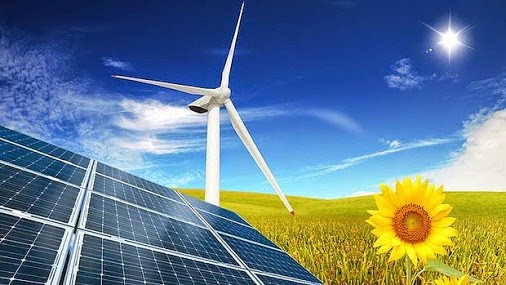Renewable energy sources may be a hot topic in today’s environment but the concept is far from new. Some forms of renewable energy have been practiced for centuries. From the moment the first caveman rubbed two sticks together to start a fire, renewable energy was being used to provide heat or cook food. The sun, long before it was recognized as an engine to produce solar power, was quietly doing its job of warming the earth and producing light. Two main factors are the driving forces in the development of renewable energy sources. First of all, renewable energy sources such as solar power or wind power are environmentally friendly as they do not emit greenhouse gases. Equally as important, renewable energy sources are just that, renewable. They cannot be depleted in the same way as natural gas, coal or oil supplies. What exactly constitutes a renewable energy source? There are five main types. 1) One of the oldest forms of renewable energy is  what is known as biomass energy. This form of energy is created from organic materials, such as when wood is burned to create heat. Today’s technology makes it possible to use plants, agricultural residue or even the organic remains from industrial waste as biomass to create energy. Common products being tested and marketed include new formulations of gasoline for automobiles being produced from corn, burning biomass to generate electricity and using biomass in products traditionally produced from petroleum. 2) Solar energy in its raw state has been around since the dawn of time. It is estimated that every hour of sunlight on the earth produces enough solar energy to accommodate the energy needs of the planet for an entire year. Harnessing that energy is the key to energy sufficiency in the future. Solar panels are becoming more common in industry and homes as heating solutions. On a larger scale, power plants make use of solar energy to generate electricity. 3) Wind has been used to power windmills used to grind grain or channel water long before the use of wind power was thought of as a renewable energy source in other areas of society. Windmill farms are becoming a booming industry. Wind turbines are used to capture the wind and turn it into electricity to support homes and businesses. Wind is a near perfect source of renewable energy. It is pollution free and, once the turbines used to harness its power are in place, the wind itself is free of charge. 4) Geothermal energy is a renewable energy option generated by heat beneath the surface of the earth. There are some limitations on its use as it is found in hot springs, geysers or volcanoes, sources not universally available. Power stations that supply geothermal energy must be located in areas where these geological features already exist. The energy is acquired through geothermal springs and is perpetually renewed by rainfall to restore the water supply that is heated beneath the earth’s surface. Despite the geological limitations of geothermal energy, the world resource supply has been estimated to be greater than the supply of coal, gas, oil and uranium combined. 5) Hydroelectricity is energy supplied by moving water. This energy source is another one that has been in use for centuries. Early farmers created water wheels to grind grain or irrigate crops. As far back as the late nineteenth century hydropower was harnessed to power the street lamps in Niagara Falls. Today, hydropower is the cheapest method of generating electricity. Once the hydro plants are in place and operational, the water, which is the source of energy, is free. Like the wind, it is replenished by nature on a steady basis. Renewable energy sources are increasingly critical topics in today’s society. We can no longer rely on the depleting natural resources of gas, coal or oil to carry us through into the next century. These resources will not be naturally replenished and, because of their relative scarcity, they are often used as political control issues by countries with plentiful supplies in their dealings with countries that need those resources. Renewable energy options will provide the answers to future energy needs.
what is known as biomass energy. This form of energy is created from organic materials, such as when wood is burned to create heat. Today’s technology makes it possible to use plants, agricultural residue or even the organic remains from industrial waste as biomass to create energy. Common products being tested and marketed include new formulations of gasoline for automobiles being produced from corn, burning biomass to generate electricity and using biomass in products traditionally produced from petroleum. 2) Solar energy in its raw state has been around since the dawn of time. It is estimated that every hour of sunlight on the earth produces enough solar energy to accommodate the energy needs of the planet for an entire year. Harnessing that energy is the key to energy sufficiency in the future. Solar panels are becoming more common in industry and homes as heating solutions. On a larger scale, power plants make use of solar energy to generate electricity. 3) Wind has been used to power windmills used to grind grain or channel water long before the use of wind power was thought of as a renewable energy source in other areas of society. Windmill farms are becoming a booming industry. Wind turbines are used to capture the wind and turn it into electricity to support homes and businesses. Wind is a near perfect source of renewable energy. It is pollution free and, once the turbines used to harness its power are in place, the wind itself is free of charge. 4) Geothermal energy is a renewable energy option generated by heat beneath the surface of the earth. There are some limitations on its use as it is found in hot springs, geysers or volcanoes, sources not universally available. Power stations that supply geothermal energy must be located in areas where these geological features already exist. The energy is acquired through geothermal springs and is perpetually renewed by rainfall to restore the water supply that is heated beneath the earth’s surface. Despite the geological limitations of geothermal energy, the world resource supply has been estimated to be greater than the supply of coal, gas, oil and uranium combined. 5) Hydroelectricity is energy supplied by moving water. This energy source is another one that has been in use for centuries. Early farmers created water wheels to grind grain or irrigate crops. As far back as the late nineteenth century hydropower was harnessed to power the street lamps in Niagara Falls. Today, hydropower is the cheapest method of generating electricity. Once the hydro plants are in place and operational, the water, which is the source of energy, is free. Like the wind, it is replenished by nature on a steady basis. Renewable energy sources are increasingly critical topics in today’s society. We can no longer rely on the depleting natural resources of gas, coal or oil to carry us through into the next century. These resources will not be naturally replenished and, because of their relative scarcity, they are often used as political control issues by countries with plentiful supplies in their dealings with countries that need those resources. Renewable energy options will provide the answers to future energy needs.
